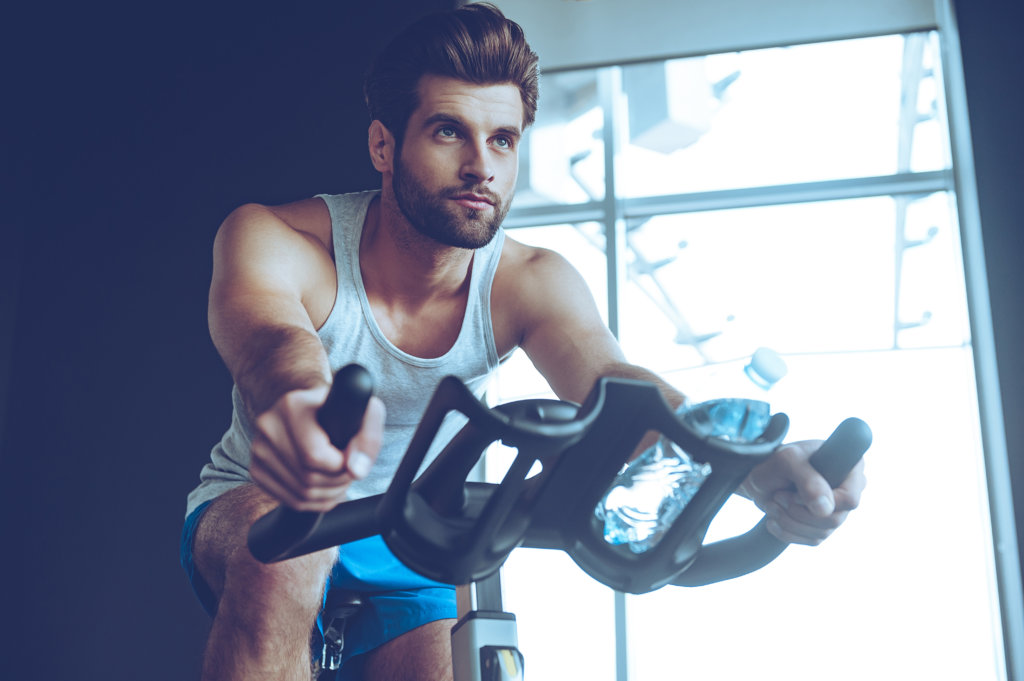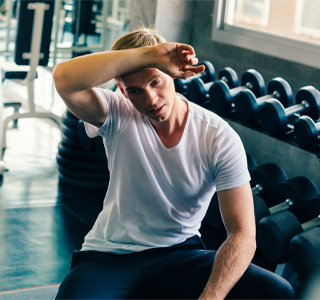Tips To Push Through Workout Fatigue
Everyone has felt their muscles burning or their body shaking after holding a plank for a few seconds too long or trying to push those last few reps out. New research suggests that your muscle might not actually be tapped, but instead are getting contradicting messages from your brain.
In short, when you are working out, your mind is the one that needs to be conditioned to get past the screaming-muscles moment that makes you want to quit. With every bicep curl or step on the treadmill, your muscles send signals to your brain, telling them exactly what they need to continue working – specifically, oxygen and other fuel – and reporting their level of fatigue. The brain takes these messages and responds accordingly, adjusting muscle contraction demands. If we are able to train our brain to respond to muscle signals in certain ways, we can maximize our workouts.
Recognize your triggers

Understanding what triggers your fatigue is the first step. The signal to drop the weights or your body during a workout comes from one of two places: your muscles or your central nervous system. What experts call “peripheral fatigue” is a decrease in your muscles’ ability to generate power, while “central fatigue” originates from the latter. Until recently, many thought that peripheral fatigue dictated the threshold at which your muscles would give up.
However, new research in the journal Medicine & Science in Sports & Exercise found that the brain typically underestimates how much you have left to give, and in response, asks your muscles to give less effort. In the study, cyclists completed three rides of varying intensities until they reached exhaustion. They lasted an average of three minutes at sprint speed, 11 minutes at a race pace, and 42 minutes at a challenging endurance pace. Using an electrical stimulation technique, the researchers were able to measure both central and peripheral fatigue after each ride in order to pinpoint which fatigue may have triggered the muscles to give up. While peripheral fatigue peaked during the short stints and central fatigue was the lowest, central fatigue was higher during the longer distance, which means the brain reduced action from the muscles even though they had not actually maxed out.
Another study was conducted that back this theory up. The researcher Amann injected exercisers with a spinal nerve block that restricted signals from traveling from the legs to the brain. Then, he had them cycle as fast as they could on a stationary bike for 3.1 miles. In the end, every cyclist needed help to get off the bike because of their level of exertion. Since their central fatigue system was blocked, the cyclists could push past their normal thresholds. Their muscles ended up fatiguing 50 percent more than they would have had the fatigue systems warned them they were approaching an exhaustive state.
Obviously, if you feel as though you may pass out, are dizzy, or nauseated, slow down. But most of the time, your muscles should not determine your workout, and they will continue to push even after your brain has asked them to stop. Below are three methods to help you break through the wall your brain puts up.
Trick your brain

At the beginning of any workout, you likely feel energized and excited. But, after a few miles, or when you are nearly the end of your sets, every movement from your body feels slow and difficult. While physical responses like glycogen depletion and buildup of metabolites worsen this struggle, it is not enough to account for the added difficulty. Performance is typically not limited by muscle fatigue but rather by perception of effort. Limits are created by what our brain assumes we are feeling instead of what may actually be happening in our muscles.
A study published in the Journal of Applied Physiology followed 16 cyclists who rode to exhaustion after 90 minutes of either a mindless task or a demanding cognitive task. The riders who had completed the demanding cognitive task times to exhaustion were much shorter than the other group. The mentally fatigued group also perceived their effort to be much higher during the cycling test. The upside to this is that any trick that reduces the perception of effort would improve an endurance performance.
The first trick is to keep positive thoughts at the forefront of your mind as you are working out. Then, force your brain to associate exercise with something that feels good. Attempt to smile during the most difficult parts of your workout so that the muscles – even those associated with frowning – that stimulate thoughts of exhaustion are less active. If you lighten your mental load, just like lightening your physical load, you can go stronger and longer.
Push through the burn

Your muscles get plenty of oxygen during everyday movements, but when you push yourself further your aerobic system struggles to keep up with your energy demands, causing your muscles to switch to their auxiliary power. This switch causes the muscles to go through their fuel stores and causes a buildup of metabolites.
Going through fuel stores and building up metabolites triggers fatigue. However, burning or shaking muscles just give you a warning that you are approaching exhaustion, they are not necessarily your actual limit. Your brain will not allow your muscles to completely bottom out, but you can instruct your brain to respond more casually to the metabolite buildup. For example, the more you practice an exercise, like running, the less likely your muscles will signal to your brain to stop.
Pick the right beverage

A study published in The Journal of Physiology found that cyclists who wet their mouth with and then spit out a sports drink finished a time trial at least a minute ahead of the control group. Functional MRI scans showed that reward centers in the brain were activated when drinking the carbohydrate drink. The body though it was getting more fuel and pushed harder.
For those who would actually like to swallow their drink, caffeinene might do the trick. Having two or three cups of coffee before a workout causes the body to require less brain activity to produce muscle contractions.
